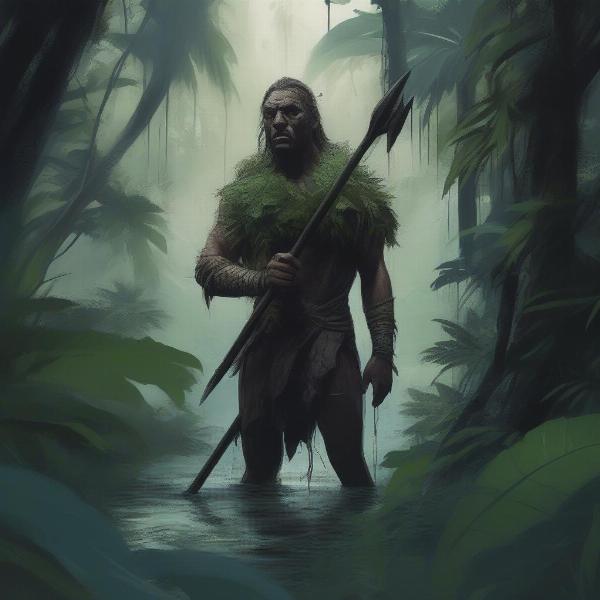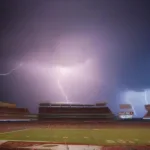The setting of Richard Connell’s thrilling short story, “The Most Dangerous Game,” plays a crucial role in building suspense and shaping the narrative. It’s more than just a backdrop; it’s a character in itself, influencing the actions and fates of the protagonists. This article delves deep into the intricacies of the setting, exploring its significance and impact on the story’s overall meaning.
After the opening scene depicting Rainsford’s fall from the yacht, the story quickly establishes its primary setting: Ship-Trap Island. This ominous name immediately foreshadows the danger that awaits. The island is described as isolated and shrouded in darkness, with a reputation so sinister that even seasoned sailors fear its presence. Its remoteness fosters a sense of isolation and vulnerability, cutting Rainsford off from civilization and trapping him in a nightmarish game of survival. The island’s dense jungle, filled with treacherous terrain and unknown dangers, adds another layer of suspense. It’s a labyrinthine world where Rainsford is constantly disoriented and at a disadvantage, making him feel like prey in Zaroff’s twisted hunt.
The jungle’s oppressive atmosphere, with its thick foliage blocking out sunlight and creating a sense of claustrophobia, further enhances the feeling of dread. The island’s eerie silence, broken only by the rustling of leaves or the distant cries of unseen creatures, contributes to the overall sense of unease and foreboding. It’s a place where anything could be lurking just out of sight, keeping both Rainsford and the reader on edge. The specific setting of Ship-Trap Island is integral to the plot. It allows Zaroff to create his hunting grounds and maintain his gruesome game. Its isolation and dangerous terrain provide the perfect conditions for a deadly pursuit, making escape nearly impossible. This creates a heightened sense of danger and suspense, driving the narrative forward.
Similar to the conflict presented in what’s the conflict of the most dangerous game, the setting intensifies the power dynamics between Rainsford and Zaroff.
 Ship-Trap Island Setting in The Most Dangerous Game
Ship-Trap Island Setting in The Most Dangerous Game
The Importance of the Chateau
While the island itself is a crucial part of the setting, Zaroff’s opulent chateau provides a stark contrast to the primal wilderness surrounding it. This grand, almost gothic structure, serves as a symbol of Zaroff’s civilized veneer masking his barbaric nature. The chateau’s luxurious interior, filled with trophies of past hunts, is a chilling reminder of Zaroff’s cruel hobby. The juxtaposition of the chateau’s elegance with the savagery of the hunt underscores the story’s central theme of the duality of human nature. The chateau’s presence adds another layer of complexity to the setting. It represents the thin line between civilization and savagery, highlighting the potential for darkness that lies within even the most refined individuals. The contrast between the chateau and the jungle also emphasizes the psychological battle between Rainsford and Zaroff, as Rainsford is forced to confront his own primal instincts in order to survive.
How the Setting Influences the Characters
The setting of “The Most Dangerous Game” has a profound impact on the characters, particularly Rainsford. As a renowned hunter, he is initially confident in his abilities. However, the island’s unfamiliar and hostile environment quickly strips him of his composure, forcing him to rely on his instincts for survival. The setting acts as a catalyst for Rainsford’s transformation, pushing him to his limits and revealing his own capacity for both cunning and ruthlessness.
For Zaroff, the island is his personal playground, a place where he can indulge his twisted desires without consequence. The setting reinforces his sense of power and control, allowing him to play God with the lives of others. You can learn more about the main character by reading who is the main character in the most dangerous game.
 Zaroff's Chateau in The Most Dangerous Game
Zaroff's Chateau in The Most Dangerous Game
What Does the Setting Symbolize?
The setting of Ship-Trap Island can be interpreted as a symbol of the human psyche. The island’s dark and untamed wilderness represents the primal instincts that lie beneath the surface of civilized behavior. Zaroff’s chateau, with its veneer of sophistication, symbolizes the facade of civility that can mask a darker nature. The setting, therefore, serves as a powerful metaphor for the internal conflicts and moral ambiguities that exist within humanity.
Why is Knowing the Setting Important?
Understanding the setting is essential for a complete appreciation of “The Most Dangerous Game.” It adds depth and complexity to the story, enhancing the suspense and contributing to the overall thematic significance. Without the specific setting of Ship-Trap Island, the story wouldn’t have the same impact. The island’s isolation, its dangerous terrain, and the contrasting opulence of Zaroff’s chateau are all essential elements that contribute to the story’s chilling atmosphere and thought-provoking themes.
If you’re interested in learning more about rising action in stories, check out our article on what is the rising action of the most dangerous game.
 Rainsford in the Jungle in The Most Dangerous Game
Rainsford in the Jungle in The Most Dangerous Game
Related Insights: Game Settings and Their Impact
The impact of setting on a narrative isn’t unique to “The Most Dangerous Game.” Think about your favorite video games. Whether it’s a sprawling open world or a claustrophobic space station, the setting always plays a crucial role in shaping the player’s experience. It dictates the challenges they face, the atmosphere of the game, and often the underlying themes. Exploring the settings of other games can provide a deeper appreciation for the artistry and intentionality behind their design. For example, have you ever wondered when is the bedlam game? Or perhaps you’re interested in learning how to play sandman game? Exploring these different game settings and mechanics can broaden your understanding of how setting contributes to a compelling experience.
Conclusion
The setting in “The Most Dangerous Game” is more than just a location; it’s a vital element that drives the plot, shapes the characters, and contributes to the story’s enduring power. The isolated and dangerous Ship-Trap Island, with its dense jungle and imposing chateau, creates a palpable sense of suspense and dread. By understanding the setting’s significance, we can gain a deeper appreciation for Connell’s masterful storytelling and the complex themes he explores. What are your thoughts on the setting? Share your perspectives in the comments below!

